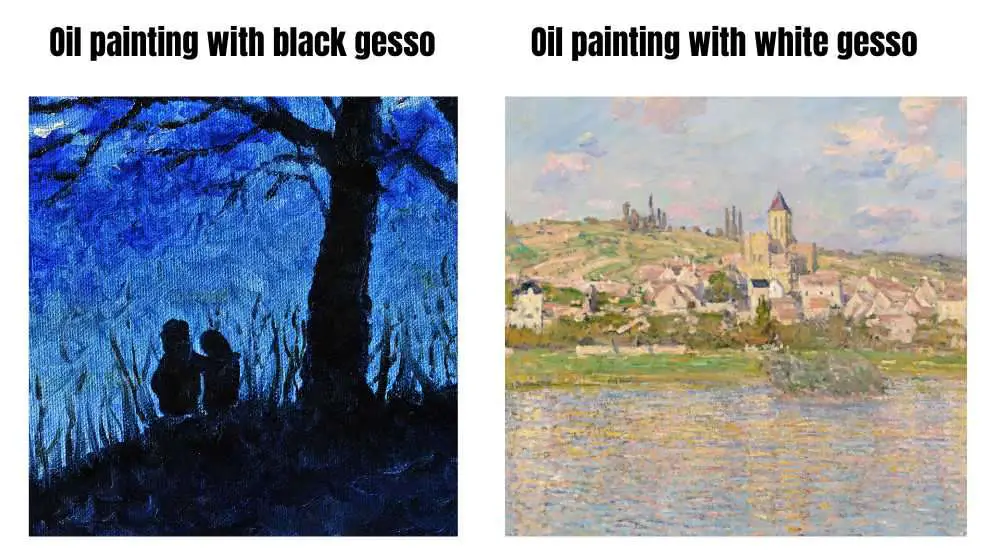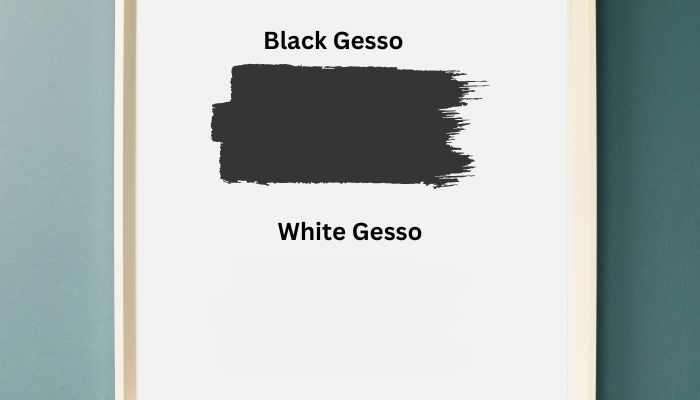Every beginner artist must be familiar with gesso but I am pretty sure that the majority don’t know the difference between white gesso and black gesso. As gesso is an essential element when it comes to oil painting because it is really important to prime a canvas with gesso to get the oil paint to stick to the canvas.
This blog aims to deliver the complete difference between white gesso and black gesso, their advantages, and which one is the most valuable for oil painting. As a beginner, you can only differentiate them by their appearance but there are many other things that you should know about them. So, let’s discover everything which you need to know about white gesso vs black gesso!
White gesso is great for adding another priming layer which helps the canvas from soaking up all the oil paint. It’s great for blending and spreading colors across the painting surface. On the other hand, black gesso is great for toning canvas which gives a darker base to start oil painting on. You can create some beautiful effects with a darker base like Bob Ross.
Table of Contents
- What is black gesso?
- What is black gesso used for?
- Advantages of using black gesso
- What is white gesso?
- Advantages of using white gesso
- Can we use white and black gesso for the same purpose?
- Difference between white gesso and black gesso
- Recommend watching
- Final Words
- FAQs
What is black gesso?
Black gesso is a type of primer that is used to prepare a black surface for oil painting. It is made by a combination of black pigment, glue, and some additives. Additives are mainly the same as we use for making white gesso but we replace white pigment with black.
Similar to white gesso, we apply the black gesso to the canvas before starting oil painting to create an even, darker, and smooth surface to make sure the oil paint adheres to the surface properly.
Bob Ross also used black gesso in one of his oil painting tutorials in which he created a darker base and then used oil paint to create the lighter areas which brings fantastic results.

What is black gesso used for?
Black gesso is a primer that is used by artists to create in-depth contrast with a darker background. It is also widely used to conceal imperfections which usually cannot be visible due to the darker base. The texture of black gesso is really smooth and similar to white gesso.
Gesso was first invented by Henry Levison in 1955 but black gesso was introduced by Bob Ross in his tutorials as he invented it. Fairly, there are no exact details about the invention of the black gesso.
Black gesso is usually applied with a paintbrush like white gesso and it also dries in just a few minutes (20 minutes) depending on the thickness of the layer. With black gesso, you can paint on the undertone to ground or black in for the final artwork.
Advantages of using black gesso
A darker surface can be really helpful to hide the visible mistakes from the painting. The idea of using black gesso gives you a different level of transparency and the working quality of the paint. As not all oil paints are opaque, they can be transparent also, using black gesso make the color significantly different.
Using black gesso can make you realize that the underlying color of your oil painting really does matter because you can create another level of artwork if you understand it properly.
Black gesso is also exceptional in improving the adhesion of your oil paints. By using black gesso, artists can make sure that their oil paints will adhere to the canvas.
What is white gesso?
White gesso is a permanent, non-yellowing, and flexible coating that is used to create a smooth surface for the application of oil paints. It is usually used to seal surfaces for oil paintings with a white coating. White gesso can be used for oil, acrylic, and even sketches. Every beginner starts by using white gesso to paint on the canvas.
You can say white gesso is a universal primer for oil painting because it is the most common type of gesso used for oil painting. If you are a beginner, you should be aware of the difference between liquid white and gesso.
White gesso was first introduced by Henry Levison in 1955 who created it with a mixture of glue, white pigment, and gypsum. It can also be made by mixing plaster of Paris with white pigment and a binder.
Advantages of using white gesso
The first advantage we get while using gesso is the adhesion of the paint because oil paint is not going to stick well without any support. Secondly, white gesso works to seal the small holes in the canvas which cause the paint to come out and a lot of oil paint will waste after getting soaked by the canvas.
As Bob Ross once said, “We don’t make mistakes, we just have happy accidents”. There is no wonder that Bob Ross said 100% truth but he also give us a way to avoid these happy accidents by using gesso. Yes, Gesso is greatly helpful to take control of your oil paints.
Gesso can also be used to reuse the canvas when your oil painting goes bad. In order to reuse the canvas, just apply a single coating of gesso over the old oil paint, let it dry, and reuse it.
Can we use white and black gesso for the same purpose?

Yes, black and white gesso can always be mixed together in order to get a lighter shade of white. However, it is important to use those pigments which give a good contrast with the color of the gesso used.
As black gesso is darker in color, it gives a dark grey color after mixing with white gesso. It can be a unique idea to create some beautiful artwork.
Difference between white gesso and black gesso
White and black gesso are both the same in working but the main difference is the color which creates a big impact on the base of the surface. White gesso is used for common and lighter oil paintings but black gesso is used for moody and dark paintings.
A dark base is used to create a sense of depth, shadow, or a dramatic tone. I have given two oil paintings below in which one is primed with white gesso and the other with black gesso.

Recommend watching
Final Words
If you want to prime the surface with gesso, white and black gesso works the same but there will be a color difference in the base of the canvas which will change the whole output of the painting. Using black gesso is recommended for only those artists who professionally know the working of oil paints with different shades and contrast.
As a beginner, I really suggest staying on the white canvas because it is basic to understand your mediums. Once you master the basics, you can move on to black gesso because it has some magical results which are really interesting to watch.
FAQs
Did Bob Ross invent black Gesso?
Bob Ross was the one who first taught about the use of black gesso as he invented it. Black gesso is the same as white but it has an addition of black pigment. However, there is no exact answer in history about the invention of the black gesso but the Bob Ross introduce it to the public.

You should NOT gesso over a failed oil painting. It doesn’t give a permanent painting surface and the paint will crack and flake off. Use a white lead primer to reprint. I use oil primed linen canvas for oil paintings.
Hey Norma,
Glad to see you here!
We know that this answer was directed towards “Gesso can also be used to reuse the canvas when your oil painting goes bad. In order to reuse the canvas, just apply a single coating of gesso over the old oil paint, let it dry, and reuse it”
Here we are talking about just the advantages that means artists used to apply gesso over the old paintings to reuse them. However, there are some exceptions that could be cover only if we take the topic deeper. Here, just to heighlight the advantages of gesso, it was compulsory to mention every advantage weather it requires additional efforts or some substitutes. I hope you got us.
Regards,
PaintingFox Media Writer: M Uzair Younas